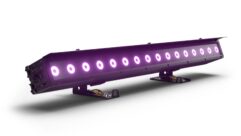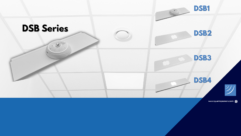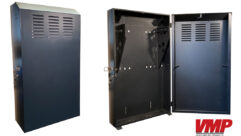MOUNTING OPTIONS
Aug 1, 2001 12:00 PM,
By Bruce Laughton & Bob Ogden
The time you spend gaining a complete picture of what the customer wants will pay huge returns at the end of the job. It is also where you get the chance to anticipate potential installation problems.
The key to a profitable A/V installation is having as many potential solutions as you need to tailor the installation to the customer’s requirements without saddling yourself with time- and profit-consuming work-arounds.
“NO PROBLEM CAN DO!” YOU SAID IT ON FRIDAY, AND ON Monday, you can’t sleep. In fact, these words will guarantee an occasional sleepless night for the A/V installer. Your customer expects you to be confident, and as the pro, you know you can do it…but the devil is in the details. It’s the handling of these challenges quickly and effectively that keeps your “No problem” from becoming no profit.
Benjamin Franklin updated a seventeenth-century medical proverb for his Poor Richards Almanack. Today, it still fits the installation challenge: “An ounce of prevention is worth a pound of cure.” The perfect installation includes a satisfied customer saying, “It looks exactly like I thought it would, works great, and is trouble-free and safe. And it’s on time.” It also includes a contractor who is on time, on budget, available for service calls and ready to tackle repeat business. So, how do we achieve that?
THE INFORMED CUSTOMER
The perfect installation starts long before you get the job. It starts with listening to the customer. While the customer is always right, they are not always well informed. Early on, you should teach them about the equipment, its capabilities and its limitations. This process will occasionally lead the customer to a better solution, building considerable trust and loyalty.
The tricky part is determining how they want their new system installed. While prices continue to drop, A/V equipment still represents a sizable investment. The time you spend gaining a complete picture of what the customer wants will pay huge returns at the end of the job. It is also where you get the chance to anticipate potential installation problems. See the sidebar on the golden rules for no-problem installations.
IN CONTRACTORS’ LANGUAGE
Let’s look at some of the means for achieving the customer’s goal. Most installations will fall roughly into one of two categories:
Exposed Mounting Systems
Projector manufacturers spend a lot of time and money making the casework and overall package esthetically pleasing. Leaving the projector or plasma display unit exposed is often acceptable. This is likely to continue as projectors get smaller and less obtrusive.
Hidden Mechanisms
These are for the upper-end installations. Whether for looks or for security, the customer wants the device out of sight when not in use.
Helping a customer review available brackets and mechanisms is an excellent way for the contractor to understand the customer’s viewpoint. This discussion has the added benefit of attaching the customer’s requirements to readily available, non-custom technology. This is good for their bottom line and yours. So, let’s take a look at exposed and hidden mountings as they pertain to both LCD/DLP projectors and plasma display panels.
Exposed Projection Systems
Most projectors are ceiling-mounted at the end of a pipe mount or other extension system. Installers have told us repeatedly that not all of the many available mounts are created equal. And lowest up-front cost may not be cost effective in the long run. There are a number of factors to weigh when considering an exposed mounting system:
For the Customer:
Looks
How does it look? Does the mounting system dwarf the projector?
Vibration Resistance
Does it provide sufficient rigidity to keep the projector from wiggling or vibrating during use?
Ease of Use
How easy is it to use? Does projector servicing cause registration loss? Do you have to disassemble the mounting system to get to the bulb or filter-access points? Do you need to drag out the toolbox to accomplish simple servicing tasks?
For the Contractor:
Assembly Time
How much assembly is needed before the installer can hang it?
Registration
How difficult is it to achieve projector registration? Roll, pitch and yaw will ideally be easy to access with the projector mounted and operating. Some systems have locking mechanisms with the frustrating tendency to change the very alignment you are trying to preserve. Will the system retain registration?
Brackets
When buying brackets, small savings in up-front costs can turn into sizable hidden costs, eroding already thin profit margins and straining customer satisfaction. Here’s what you need to know to order the right bracket:
- What kind of projector will be mounted to what kind of ceiling?
- What accessories will you need to incorporate the mount into that ceiling?
- How much drop will you need to get the right projection height?
- What do local building codes require for an installation of this nature?
Hidden Projection Systems
The totally concealed system generally involves a lift mechanism that draws the projector into the ceiling when not in use. Things to consider in hidden-mounting systems include:
- How much downward vertical travel does the lift need to provide?
- What is the height of the lift in the up position?
- How much vertical space is available above the ceiling to accommodate it?
- What are the relative dimensions of projector and lift? Will they work together?
- How soon can the parts ship? Ideally the manufacturer ships within one week.
- How easy is it to align the projector? Does the lift allow movement fore and aft, side to side, as well as roll, pitch and yaw?
- Is the drop to projection height consistent and repeatable?
- How easy is it to remove the projector for servicing?
- Can the lift be opened in the event of a power failure?
- What will the ceiling mount attach to (e.g., suspended ceiling, finished ceiling)?
- What do local building codes require for an installation of this nature?
A word of caution about suspended ceilings: They always promise to be quick and easy installations, but beware Murphy’s law. No matter where your customer wants the unit installed, there will always be an HVAC duct or structural member in the way. You may still be able to salvage the situation. If you have sufficient clearance under the duct, threaded rod, using turnbuckles for leveling, is an excellent way to get around the duct. The bottom-line is to take the time to look above the ceiling tile before you say, “No problem.”
Coordinating with the Electricians
When installing a ceiling lift, work out a thorough mounting plan ahead of time, calculate exactly where you are going to cut those holes, and make sure you have electrical power available. Always tell the electrician about the installation. You’ll find that life is easier if you have an extra outlet for a light or for electrical tools during installation and maintenance.
LCD/DLP projection systems have carved out a strong following in home theater. Selecting a mounting system that allows you to say, “No problem,” with confidence is key to your profitability.
Exposed Plasma Display Systems
Plasma display mounting options are even more diverse than for LCD/DLP projection systems there are more places to put these units. Add to this the feeling of familiarity borrowed from experience with the family television set, and you’ll find that customers tend to get pretty creative with PDPs. The most common home theater applications are wall-mounted systems and hidden mechanisms.
WALL-MOUNTED PLASMA DISPLAYS
Plasma display technology is in its relative infancy, and potential mounting methods are still evolving. The required wall clearance for PDPs is decreasing, but the major equipment manufacturers still specify cooling space behind their units.
Wall-mounting technology today falls into the following categories:
- Static mounts provide a secure, but fixed way to attach a plasma display to the wall (no tilt or swing).
- Pitch mounts perform much the same task as the static mounts, except they allow the user to tilt the PDP to a preferred viewing angle.
- Pivot mounts allow the PDP to be swiveled and tilted to achieve the ideal viewing angle.
- Pull-out swing-arm mounts are similar to pivot mounts. But these mounts allow the plasma panel to be pulled out from the wall and turned up to 90þ in either direction.
- Height-adjustable mounts allow the plasma display to be manually raised and lowered on a track system, providing an array of viewing heights.
Factors to consider when looking at wall-mounting systems for plasma displays:
For the Customer:
Low Profile (Invisibility)
People who buy plasma displays do not want to see mounting hardware. The most effective mounting systems will hide behind the plasma display and will keep it as close to the wall as allowed by the manufacturer.
Touch, Feel and Convenience
The bracket should be designed to hold the plasma without calling attention to itself. Are the adjustments intuitive? Does it sag or bend under the weight of the display? Does it retain its alignment throughout the range of movement? Does it require a contortionist with a tool belt to adjust it?
Safety
Does the plasma unit attach securely?
For the Contractor:
Time
How much assembly is required before installation? This varies, but five minutes is reasonable. Are there provisions for cord routing and management? How quickly and easily does the plasma attach to the mount? Will the unit be firmly attached? Can the installer get at the cord attachments after the plasma is in place?
Weight
Contractors must be aware of the applicable building codes within their area. The codes for earthquake-prone areas will be more stringent than in other regions. No matter where you are, you will need to tie into the wall studs or supporting framework for a safe installation.
Remember that you are hanging 80 to 120 pounds or more. If you are using a pitch mount, or especially a pull-out swing-arm, the customer will be repeatedly testing your mounting job, with both time and leverage on their side. So, when in doubt, reinforce! If you are unsure how to reinforce, consult a building construction professional.
Power and Signal Cords
Each make of plasma display will have its own location for power and signal cables. Swing-out and pivot mounts will typically have the cords going through a cable management system, then routed as needed. For static and pitch mounts, you will want to know the make and model of the plasma you will be installing and plan the placement of the wiring and cabling accordingly.
CEILING-MOUNTED PLASMA DISPLAYS
These are available but are usually reserved for public buildings or retail establishments. The most common type is a pipe-mount system holding a single or a double (back-to-back) plasma mount.
Hidden Plasma Display Systems
The most common mechanism for hiding a plasma display is a lift mechanism incorporated into a credenza, cabinet or the foot-board of a bed. There are also ceiling lifts. When looking for a lift mechanism for a plasma display, you should ask:
- How quiet is the unit during operation?
- Will the lift suffice for the total weight being lifted (panel, cabinet top, etc.)?
- How heavy is the lift itself relative to the weight that can be supported by the ceiling?
- Will the lift allow the customer to access the display’s controls?
- Are there provisions for safety strips to prevent pinched fingers?
- Is the footprint of the unit thin enough?
As you turn to the installation itself, you’ll need to ascertain the answers to these questions as well:
- What are the PDP’s make and model?
- How much lift or drop will your installation require?
- What kind of controller will be used with the unit?
- What are the dimensions of the cabinet within which you must work; or how much clearance is there above the ceiling?
Other Plasma-Mounting Options
In addition to the common mounting options, there are also carts, floor stands and table stands, offered at a variety of price points.
NO PROBLEM…IF YOU PLAN FIRST
The key to a profitable A/V installation is having as many potential solutions as you need to tailor the installation to the customer’s requirements without saddling yourself with time- and profit-consuming work-arounds. Take the time to find the mounting hardware companies who provide value-added customer service as well as mount designs that have both the customer and the installer in mind. Accomplish this and you’ll be able to say, “No problem,” and mean it!
Bruce Laughton and Bob Ogden work at Chief Manufacturing in Savage, Minnesota. For more information, contact them at[email protected]or[email protected].
The Golden Rules for No-Problem Installations
- The customer’s mind’s-eye view is always clearer and more detailed than their description of it to you. It’s nearly impossible for them to convey their entire vision in words or drawings; but get as much as you can, suggest viable ideas and stay flexible.
- The customer’s initial vision will very often exceed their budget. Know this in advance so that you can keep your plans in touch with reality and customers aware of monetary restraints.
- The greater the gap between the customer’s idea and your understanding of it, the more you will bear the expense of changing the installation to satisfy them. If you need practice at understanding customers, you’ll invariably get it!









